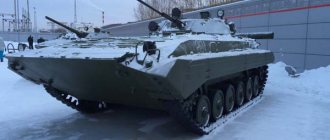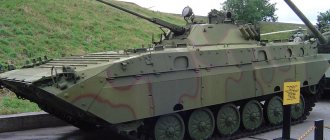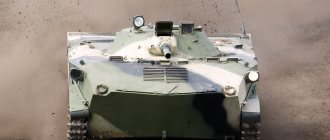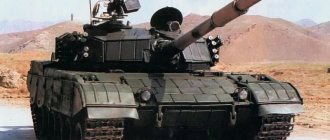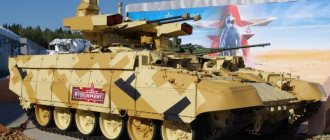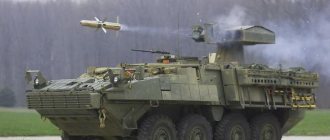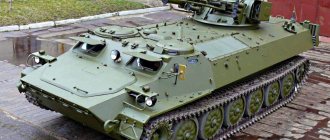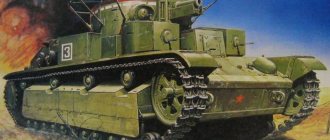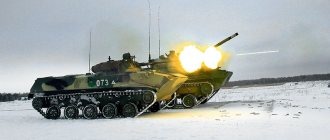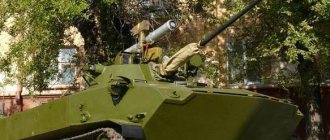The M2 Bradley is a heavy American infantry fighting vehicle designed to both transport infantry and provide close support in combat. The M2 Bradley BMP was developed at the height of the Cold War for the European theater of operations, as a response to the creation of the Soviet BMP-1 and BMP-2. Since then, these vehicles have taken part in several conflicts and have shown their effectiveness both in clashes with regular units and in counter-guerrilla warfare.
The infantry fighting vehicle is named after General Bradley.
Currently, based on the M2 Bradley infantry fighting vehicle, a whole family of vehicles has been created that can perform a wide variety of functions. Since the start of mass production, 7 thousand vehicles of various modifications have been produced.
In addition to the US Army, the Bradley is in service with the Saudi Arabian Armed Forces.
Development history
In 1961, the American army received the M113 tracked armored personnel carrier, which for many decades became the main armored vehicle of the US Armed Forces. The M113 is still the main armored personnel carrier of the American army today; it is also used in 44 other armies around the world.
The Vietnam War showed that infantry units needed not only “battle taxis” that could transport soldiers to the battlefield, but also vehicles that could support the infantrymen in battle and go on the attack with them. In other words, an infantry fighting vehicle with more reliable protection and powerful weapons was needed. The designers tried to increase the firepower of the M113 armored personnel carrier by installing additional machine guns on it, but this did not change the situation too much.
In 1965, the XM701 appeared, which was, in essence, an attempt to increase the level of protection and firepower of the M113. The new vehicle turned out to be simply a much heavier version of the M113 and was not accepted for service. The next attempt to create an infantry fighting vehicle was the XM765 project. The M113A1 was taken as the basis; its armor protection was significantly strengthened, an automatic 20-mm cannon was installed, and the shape of the hull was changed. In 1973, the Vietnam War ended, and funding for the work was sharply reduced. But the efforts spent on development were not in vain: vehicles based on the XM765 were adopted by several countries.
Work on the creation of a new infantry fighting vehicle began in the mid-60s, but only in 1971 did the army command prepare technical specifications for the creation of a new vehicle. She received the index XM723.
The development of the new American infantry fighting vehicle took more than fifteen years; the M2 Bradley was put into service only in 1981. During this period, several new vehicles were created, some of which were deep modernization of the M113, others were completely new models of equipment.
In 1971, the XM723 project was launched. His goal was to create a simple infantry fighting vehicle with a high level of armor protection. They planned to arm the new vehicle with a 20-mm cannon, its side armor was supposed to withstand fire from a 14.5-mm machine gun, and its frontal armor was supposed to withstand fire from a 30-mm cannon. The development of the new machine was carried out by FMC Corp.
To achieve such high performance, the company's designers had to develop a fundamentally new armor protection system for infantry fighting vehicles. It consisted of several screens made of layers of steel with different hardnesses.
The outer screen was installed at a distance of 100-150 mm from the machine body and the inner screen. This design provided a level of protection superior to all materials and technical solutions existing at that time.
In 1976, testing of the new vehicle began, after which the American military department expressed its comments and prepared a list of improvements that the manufacturer needed to complete. The military insisted on installing a two-man turret with an automatic 25-mm cannon and a TOW ATGM, creating a reconnaissance modification (BRM) based on the vehicle, and ensuring the buoyancy of the new infantry fighting vehicle.
In 1977, prototypes of new infantry fighting vehicles and infantry fighting vehicles were ready: XM2 and XM3. The US leadership was asked to create and purchase new infantry fighting vehicles with an increased level of armor protection. The military justified their demands by the experience of the recent Arab-Israeli conflict and the high level of losses of the Soviet BMP-1. In their opinion, the new American infantry fighting vehicle should have a higher level of protection.
In 1979, a pilot batch of XM2 and XM3 was manufactured, and testing began. In 1981, the vehicle was put into service and was named the M2 Bradley BMP. The Americans spent $5.6 billion on the project to create a new infantry fighting vehicle. The cost of one machine, taking into account the funds spent on development, is $3.16 million.
If you compare the M2 Bradley infantry fighting vehicle with the XM723, you can immediately detect several differences: the mass of the infantry fighting vehicle adopted for service increased to 22.3 tons, the number of paratroopers decreased (to seven people), the automatic cannon of the new vehicle could hit the frontal projection of the Soviet infantry fighting vehicle -1 (with a sub-caliber projectile at a distance of 1.5 km), and TOW ATGMs can effectively work against tanks at a distance of up to 3 km.
Armament
The Bradley infantry fighting vehicles and infantry fighting vehicles are armed with a 25mm Bushmaster stabilized automatic cannon with an automatic chain drive and a dual feed system. Initially, two types of projectiles were developed for it. The high-explosive fragmentation M792 has a mass of 185 grams and is equipped with 34 grams of “Composition B”, its initial speed is 1100 m/s.
The M791 sub-caliber projectile, which is a tungsten core weighing 102 grams with a detachable tray, was intended to defeat light armored vehicles.
It penetrated armor about 60mm thick. Already at the end of the 80s, the M919 feathered armor-piercing projectile with a uranium core entered trial operation - its armor penetration exceeded 100 mm. The M240S machine gun of 7.62mm caliber is paired with the cannon.
To combat armored vehicles, TOW guided missiles are used, starting with the A1 - TOW-2 series. The mass of their cumulative warhead is about 6 kg, they can penetrate armor 900 mm thick. A launch container for two missiles is located on the left side of the BMP turret, additional ATGMs are located in the Bradley's fighting compartment.
Originally, the Bradley solved the issue of firing by paratroopers from inside the vehicle. Having reasoned that it would be impossible to conduct targeted fire from the embrasures, they installed weapons adapted for suppressing fire - M231 assault rifles.
They differed from standard M16s in the absence of a stock, a very high rate of fire, and the fire was fired from an open bolt. Only tracer bullets were used for shooting. After the appearance of the Bradley with reinforced armor, the M231, as well as embrasures in general, had to be abandoned. They are sometimes retained as crew self-defense weapons.
Modifications
The M2 Bradley BMP is the first production modification of the vehicle.
BRM M3 is a combat reconnaissance vehicle created on the basis of the M2 Bradley. Externally, it is not much different from an infantry fighting vehicle: it has capped embrasure covers and no viewing blocks. The BRM is equipped with night vision devices, has increased ammunition, and is equipped with a radar station that detects a person at a distance of 1.5 km, and a vehicle at a distance of 3 km. There are two radios and a motorcycle on the port side.
Work on improving the M2 Bradley infantry fighting vehicle began almost immediately after the first batch of vehicles was delivered to the troops. Already in 1986, a new modification appeared - M2A1/M3A1.
First of all, the vehicle's armament was improved: the M2A1/M3A1 received a cannon that could fire the more advanced M919 APFSDS-T detachable sabot projectile. To do this, the designers had to strengthen the breech of the gun and lengthen its barrel. In addition, the BMP anti-tank missile system could now fire the BGM-71D TOW II ATGM with better armor penetration.
Other structural changes were made to the vehicle: the filter-ventilation unit was improved, the ammunition stowage received a more rational placement, protective covers for periscopes were installed on the vehicle, the fire extinguishing system and fuel system were modified, and the gearboxes were changed.
As a result of the above changes, the weight of the Bradley M2A1 increased to 22.79 tons.
In 1988, the American army received the next modification of the Bradley - M2A2/M3A2. The main direction of improving the BMP was to increase the level of protection of the vehicle from 30-mm shells - the main weapon of the Soviet BMP-2 and cumulative grenades from hand grenade launchers. The main changes affected the passive and dynamic protection of infantry fighting vehicles. The spaced protection system, which was a feature of the Bradley, was retained, but completely redesigned.
Now the vehicle’s armor was made according to the “steel-aluminum-kevlar” scheme. The frontal and side armor was reinforced with steel sheets 30 mm thick; dynamic protection elements were installed on the screens, which were placed on a gasket made of special material, which reduced the impact of the explosion on the BMP body.
The inner surface of the hull was lined with a special Kevlar lining, which protected the crew from exposure to fragments. Now the Bradley could withstand fire from a 30mm gun from any direction.
In addition to armor protection, the M2A2/M3A2 modification was distinguished by a more powerful power plant (600 hp), different ammunition stowage locations and crew accommodations.
The gunner received a new sight with a thermal imager, and the radio station was replaced.
Immediately after the end of the Desert Storm campaign, work began on the next modification of the infantry fighting vehicle, it was called the A2 ODS.
The main changes concerned the electronic equipment of the machine. The BMP was equipped with a new FBCB2 BIUS, which made it possible to exchange information with satellites and other vehicles equipped with similar systems. The Bradley was also equipped with a new navigation system, a more advanced laser rangefinder and a thermal imager for the driver.
Today, the development company is working on creating a new modification of the infantry fighting vehicle - M2/M3A3. The new vehicle will be equipped with new generation electronic equipment, including thermal imagers, navigation devices and sighting devices.
Designers pay special attention to increasing the survivability of the Bradley infantry fighting vehicle in urban combat conditions. A set of improvements to old modifications of infantry fighting vehicles has been developed, which can be carried out quite easily in the field.
The military insisted on strengthening the protection of infantry fighting vehicles from mines and land mines. The designers strengthened the bottom armor, placed the ammunition in a special container, and the vehicle was equipped with special seats that protected the crew from the shock wave. The fuel tanks were equipped with an original protective system.
In addition, modernized vehicles receive new generation dynamic protection.
Bradley AMPV. This is a new program of the American military department, the goal of which is to gradually replace the outdated M113 armored personnel carriers. The vehicle that BAE Systems presented as part of this project is essentially a Bradley infantry fighting vehicle without a turret. The new armored personnel carrier has increased internal volume and enhanced armor protection. The bottom received a V-shape.
Based on the new armored personnel carrier, it is planned to create several vehicles at once to perform different functions.
Links
- "Archival copy". Archived from the original on 2010-09-22. Retrieved March 3, 2011.CS1 maint: archived copy as title (link)
- "M2A3 and M3A3 Bradley Fighting Vehicle Systems (BFVS)". Federation of American Scientists. Archived from the original on April 21, 2010.
- History of the Bradley Fighting Vehicle
- ^ abc Bradley M2/M3 Tracked Armored Fighting Vehicles, USA. Archived June 1, 2008, at Wayback Machine Army-Technology.com. Retrieved August 1, 2008 [ unreliable source?
] - "GAO Report OPERATING DESERT STORM Early Assessment of Bradley and Abrams' Effectiveness" (PDF). Archived (PDF) from the original on May 28, 2013.
- ↑
Army Bradley Brigade to Receive Israeli Anti-Missile System: Iron Fist.
Security violation
. December 14, 2022. - Diane L. Urbina. “Deadly Beyond All Expectations: The Bradley Fighting Machine”—in Chapter 12 of George F. Hoffman and Donna A. Starry (eds.), Camp Colt in the Desert Storm: A History of U.S. Armored Forces
, Lexington, Kentucky; University Press of Kentucky, ISBN 0-8131-2130-2. - James G. Burton, Colonel .
The Pentagon's Wars: Reformers Challenge the Old Guard , Annapolis, MD: Naval Institute Press (1993). ISBN 1-55750-081-9. - ^ abc Haworth, W. Blair (1999). Bradley and How It Came to Be: Technology, Institutions, and the Mechanized Infantry Problem in the US Army
. Westport, CT: Greenwood Press. ISBN 0-313-30974-4. - "Archival copy". Archived from the original on February 16, 2010. Retrieved 25 July 2010.CS1 maint: archived copy as title (link). Global Security
- Quotes from the General Accounting Office report on the performance of Bradleys and Abrams in the Gulf War
: “According to information provided by the Army Deputy Chief of Staff for Operations and Plans, 20 Bradleys were destroyed during the Other Gulf War. 12 Bradleys were damaged, but four were quickly repaired. Friendly fire accounted for 17 Bradleys destroyed and three damaged." - ↑
L. B. Thompson, L. J. Korb, C. P. Wadhams. Army equipment after Iraq. Archived March 27, 2009, at the Wayback Machine. Lexington Institute and Center for American Progress. - SABER RPG Report August 2008 Archived April 9, 2016 at the Wayback Machine
- ↑
A Quiet Farewell to M-2 Bradley, Archived July 7, 2012 on the Wayback Machine - Strategypage.com, March 5, 2012 - US Army Armored Car Puzzle Archived 2014-10-04 in the Wayback Machine - Army-Technology.com, September 11, 2014 [ unreliable source?
] - New US Army Armored Reconnaissance | Structure and equipment, retrieved 05/25/2021
- Lowry, Anthony E.; Rosa II, Peter V. "From the Screen: Cavalry Scouts in the Army of 2022". www.benning.army.mil
. Retrieved May 25, 2022. - US Army, Marines grapple with infantry vehicle replacement - Defensenews.com, April 6, 2014.
- ^ abcd M2 variants archived December 26, 2012 at the Wayback Machine - AFVDB.com
- NBC also means nuclear, biological, chemical
- ^ abcd Field Mentor 3-22.1, Bradley Artillery (November 2003). Headquarters, Army Directorate.
- ^ abc Hans Halberstadt (2001). Europa Militaria No. 30: Bradley Company.
Ramsbury, Marlborough, Wiltshire: Crowood Press Ltd. ISBN 1-86126-425-9. - ^ a b c d Michael Green and James D. Brown (2007). M2/M3 Bradley at war.
St. Paul, MN: Zenith Press. ISBN 978-0-7603-2523-0. - "Army evaluates nine vehicles against GCV in analysis of alternatives". Inside the Washington Publisher. January 2010. Archived from the original on September 28, 2010. Retrieved January 12, 2011.
- Army develops new concepts, keeps existing fleets operational - Defensenews.com, October 12, 2014.
- 'New normal' update for armor amid budget uncertainty Archived 2014-10-24 in the Wayback Machine - army.mil, October 20, 2014
- Army begins massive overhaul of combat vehicle fleet [ permanent dead link
] - Nationaldefensemagazine.org, May 6, 2015. - "Here's the Army's Plan for a Bigger, Deadlier Bradley Fighting Vehicle". Drive
. Retrieved July 21, 2022. - "BAE awards $347 million US Army contract to produce upgraded Bradley Fighting Vehicles". Defense post
. Retrieved July 21, 2022. - BAE Systems continues to supply an upgraded version of the M2 A4 Bradley tracked armored infantry fighting vehicle to the US Army. Army recognition
. June 6, 2022. - “Soldiers will control armed robots from upgraded Bradley | Article | United States Army".
- ↑
Vietnam-Vintage Vehicles Blaze Trail For Robot Tanks: Army RCV Archived September 3, 2022 at the Wayback Machine.
Security violation
. August 30, 2022. - "US supplies Bradley fighting vehicles to Lebanese army". US Embassy in Lebanon. August 14, 2022. Archived from the original on August 16, 2022. Retrieved August 15, 2022. We are at the Port of Beirut to celebrate the delivery of eight M2A2 Bradley Fighting Vehicles. These are the very first of 32 Bradleys that will be delivered in the coming months.
- Žabec, Krešimir (2019-05-18). “The government has resumed the process of acquiring new fighter jets.” List of Jutarnji
. Retrieved November 4, 2022. - “Plan a reference to the remedy for the recovery of oklopnog drove Bradley for the Ovay di Europe - novac.hr”. novac.jutarnji.hr
. Retrieved November 4, 2022. - "Croatia - Bradley Fighting Vehicle Repair/Modernization" (PDF). 2020-12-04.
- "Archival copy". Archived from the original on July 3, 2022. Retrieved 3 July 2022.CS1 maint: archived copy as title (link)
Description
The Bradley infantry fighting vehicle is designed according to a design traditional for infantry fighting vehicles: the power compartment is located in its front part, and the troop compartment is located in the rear. You can get into the landing compartment through the top hatch and rear ramp. The crew consists of three people: a gunner, a commander and a driver. Landing group - six people.
The body is welded from aluminum armor, which significantly reduces the weight of the vehicle without compromising its security. The front and side armor is reinforced with steel sheets, and the bottom is similarly reinforced. On the A2 modification, the crew is protected from fragments by an internal Kevlar lining.
The engine and gearbox are located in the front of the body on the right, with the driver's seat to the left of them.
The fighting compartment is located in the center of the BMP; there is a two-man turret with a rotating turret. The turret houses the positions of the gunner and vehicle commander.
The cannon and machine gun are stabilized in both planes, and a TOW ATGM launcher is installed on the left side of the turret.
The landing compartment is separated from the combat compartment by a partition with a passage.
The Bradley infantry fighting vehicle is armed with an automatic 25 mm M242 Bushmaster cannon, a 7.62 mm M240C machine gun, a TOW ATGM and six M231 FPW assault rifles installed in the troop compartment.
The gun has a two-belt feed.
The TOW ATGM can hit armored targets at distances of up to 3,750 meters.
The Bradley infantry fighting vehicle is equipped with a VTA-903 V-shaped turbodiesel engine with a power of 500 hp. With. (later versions have a more powerful motor). The transmission is hydromechanical, with three forward gears and one reverse gear.
See also
- Armored multi-purpose vehicle - Bradley armored personnel carrier
- BMP Development - a modern Soviet project
- GCV Infantry Fighting Vehicle - US Army development program for future infantry fighting vehicles
- List of modern armored fighting vehicles
- The M1126 Infantry Carrier Vehicle is a wheeled infantry fighting vehicle of the US Army.
- M242 Bushmaster
- Mechanized infantry
- MICV-65 was a US Army project leading to the development of the M2 Bradley.
- Warrior tracked armored vehicle - modern British infantry fighting vehicle
Combat use
Bradley infantry fighting vehicles were actively used during both American campaigns in Iraq. The machine showed high reliability and efficiency. Most of the Iraqi tanks in the first campaign were knocked out with the help of the Bradley. The 25-mm automatic cannon has proven to be a very effective and versatile weapon. It perfectly destroyed lightly armored vehicles and enemy personnel. There are several known cases when this gun disabled Iraqi tanks.
During the second campaign in Iraq, the Americans had to use Bradleys in urban battles, which led to significant losses from hand-held anti-tank weapons. Also a big problem were the land mines that the rebels planted.
The Saudi Arabian Army used the Bradley during the invasion of Yemen. During the fighting, 17 vehicles were lost.
Specifications
| Combat weight, t | 21.3 |
| Crew + landing party, persons. | 3+6 |
| Dimensions, mm | |
| Maximum height | 2900 |
| On the roof of the tower | 2580 |
| On the roof of the building | 1950 |
| Length | 6450 |
| Width | 3200 |
| Clearance | 450 |
| Track width | 533 |
| Armament | |
| Gun, brand/caliber, mm | M242 “Bushmaster” / 25 |
| Machine gun, brand/caliber, mm | M240S / 7.62 |
| ATGM | “Tou” |
| Ammunition, pcs. | |
| Shots | 900 |
| Patrons | 2340 |
| ATGM | 7 |
| Engine | |
| Brand | VTA-903T |
| Type | diesel |
| Power, hp | 500 |
| Maximum speed, km/h | |
| On the highway | 66 |
| Afloat | 7.2 |
| Cruising range on the highway, km | 490 |
| Specific ground pressure, kg/cm2. | 0.52 |
| Obstacles, m | |
| Moat | 2.54 |
| Vertical wall | 0.91 |
| Ford | floats |
| Climbing angle, degrees | 30 |
